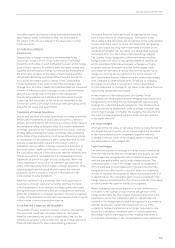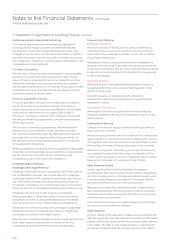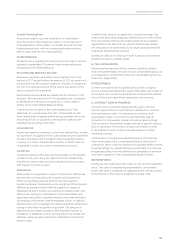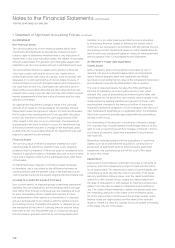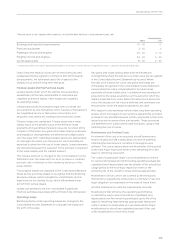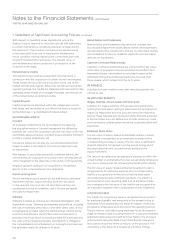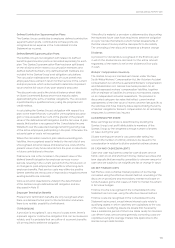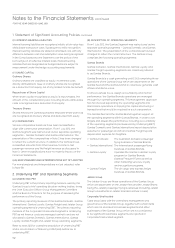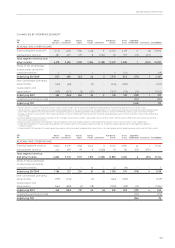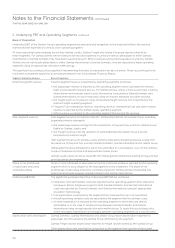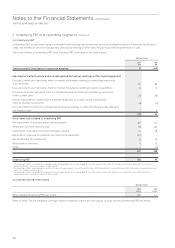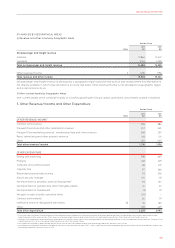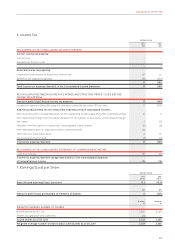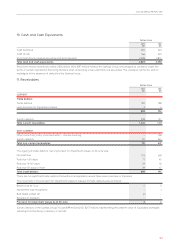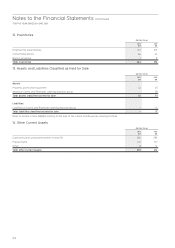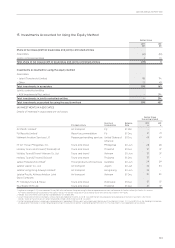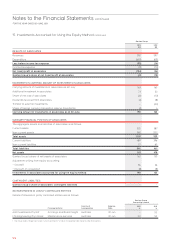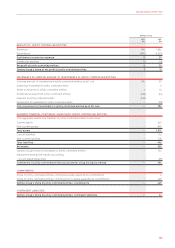Qantas 2013 Annual Report Download - page 117
Download and view the complete annual report
Please find page 117 of the 2013 Qantas annual report below. You can navigate through the pages in the report by either clicking on the pages listed below, or by using the keyword search tool below to find specific information within the annual report.
115
QANTAS ANNUAL REPORT 2013
Non-cancellable aircraft
operating lease rentals
Qantas Domestic, Qantas International and Jetstar Group report non-cancellable aircraft
operating lease rentals for passenger aircraft externally leased by the Qantas Group and
own by the segment.
Qantas Freight reports non-cancellable aircraft operating lease rentals for freighter aircraft
externally leased by the Qantas Group.
D DESCRIPTION OF UNDERLYING PBT AND RECONCILIATION
TO STATUTORY PROFIT/LOSS BEFORE TAX STATUTORY PBT
Underlying PBT is a non-statutory measure, and is the primary
reporting measure used by the Qantas Group’s chief operating
decision-making bodies, being the Chief Executive Ofcer,
Group Management Committee and the Board of Directors. The
objective of measuring and reporting Underlying PBT is to provide
a meaningful and consistent representation of the underlying
performance of the Group.
Underlying PBT is derived by adjusting Statutory PBT for
impacts of AASB 139: Financial Instruments: Recognition and
Measurement (AASB 139) which relate to other reporting periods
and identifying certain other items which are not included in
Underlying PBT.
(i) Adjusting for Impacts of AASB 139 which Relate to Other
Reporting Periods
All derivative transactions undertaken by the Qantas Group
represent economic hedges of underlying risk and exposures.
The Qantas Group does not enter into speculative derivative
transactions. Notwithstanding this, AASB 139 requires
certain mark-to-market movements in derivatives which are
classied as “ineffective” to be recognised immediately in the
Consolidated Income Statement. The recognition of derivative
valuation movements in reporting periods which differ from the
designated transaction causes volatility in statutory prot that
does not reect the hedging nature of these derivatives.
Underlying PBT reports all hedge derivative gains and losses
in the same reporting period as the underlying transaction by
adjusting the reporting period’s statutory prot for derivative
mark-to-market movements that relate to underlying exposures
in other reporting periods.
This adjustment is calculated as follows:
»Derivative mark-to-market movements recognised in the
current reporting period’s statutory prot that are associated
with current year exposures remain included in Underlying PBT
»Derivative mark-to-market movements recognised in the
current reporting period’s statutory prot that are associated
with underlying exposures which will occur in future reporting
periods are excluded from Underlying PBT
»Derivative mark-to-market movements recognised in the
current reporting period’s statutory prot that are associated
with capital expenditure are excluded from Underlying PBT
and subsequently included in Underlying PBT as an implied
adjustment to depreciation expense for the related assets
commencing when the assets are available for use
»Derivative mark-to-market movements recognised in previous
reporting periods statutory prot that are associated with
underlying exposures which occurred in the current year
are included in Underlying PBT
»Ineffectiveness and non-designated derivatives relating
to other reporting periods affecting net nance costs are
excluded from Underlying PBT
All derivative mark-to-market movements which have been
excluded from Underlying PBT will be recognised through
Underlying PBT in future periods when the underlying
transaction occurs.
(ii) Other Items Not Included in Underlying PBT
Items which are identied by Management and reported to the
chief operating decision-making bodies as not representing
the underlying performance of the business are not included
in Underlying PBT. The determination of these items is made
after consideration of their nature and materiality and is applied
consistently from period to period.
Items not included in Underlying PBT primarily result from
revenues or expenses relating to business activities in other
reporting periods, major transformational/restructuring
initiatives, transactions involving investments and impairments
of assets outside the ordinary course of business.
Segment Performance Measure Basis of Preparation


